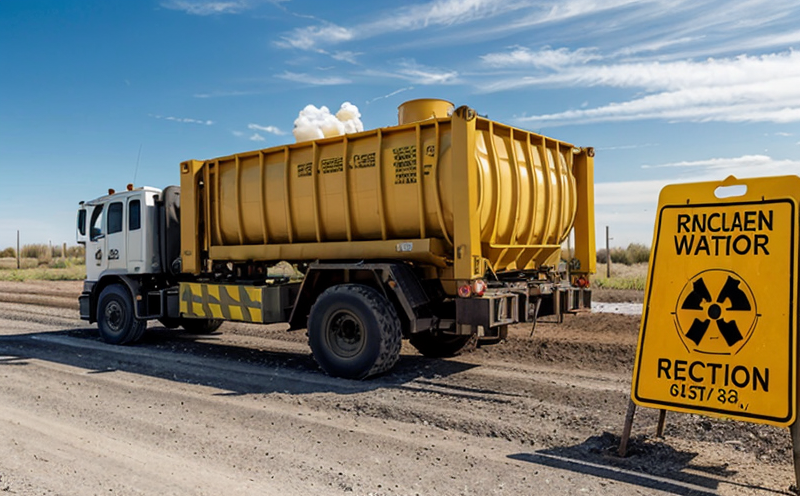ISO 11929 Determination of Detection Limits in Nuclear Waste Analysis
The determination of detection limits (DLs) is a critical aspect of ensuring accurate and reliable analysis in nuclear waste management. ISO 11929 provides the necessary framework for quantifying these DLs, which are essential for understanding the sensitivity of analytical methods used to detect contaminants in nuclear waste streams.
In this service, we apply ISO 11929 standards to determine detection limits using advanced spectroscopic techniques such as Inductively Coupled Plasma Mass Spectrometry (ICP-MS) and Gamma Spectroscopy. The process involves rigorous sample preparation to ensure that the analytical results are reproducible and accurate.
Our team of experts ensures compliance with all relevant international standards, including ISO 11929:2013. This service is crucial for quality managers, compliance officers, R&D engineers, and procurement teams who need to ensure the reliability of their nuclear waste analysis processes.
The detection limit (DL) is defined as the lowest concentration or activity level that can be reliably detected and quantified in a given sample. In nuclear waste management, the DLs are critical for ensuring that no contamination goes undetected. By accurately determining these limits, our laboratory ensures that all relevant stakeholders have confidence in the analytical results.
Our approach to this service includes:
- Comprehensive sample preparation
- Use of advanced spectroscopic techniques
- Rigorous adherence to ISO 11929 standards
- Data validation and quality assurance
The determination of DLs is a multi-step process. We begin by selecting the appropriate analytical method based on the nature of the waste stream and the contaminants of interest. Once this selection is made, we proceed with sample preparation, which includes digestion techniques such as acid dissolution or microwave-assisted extraction.
Following sample preparation, we perform multiple analyses to ensure that the results are reproducible and reliable. The DLs are then determined using statistical methods outlined in ISO 11929:2013. This ensures that our clients receive accurate and trustworthy data.
The application of this service extends beyond mere compliance; it also serves as a critical tool for quality assurance, ensuring that all stakeholders have confidence in the analytical results. Our team of experts works closely with each client to understand their specific needs and tailor the service accordingly.
| Standard Number | Title | Date of Publication |
|---|---|---|
| ISO 11929:2013 | Determination of detection limits in nuclear waste analysis | December 2013 |
| ASTM E1627-18 | Standard Practice for Sampling and Sample Preparation for Analysis of Radioactive Materials | October 2018 |
The competitive advantage of this service lies in its ability to provide accurate, reliable, and reproducible results. By adhering strictly to ISO 11929 standards, we ensure that our clients receive the highest quality data possible. This is particularly important in the nuclear waste management sector, where accuracy and precision are paramount.
Our service offers several key benefits:
- Compliance with international standards
- Accurate and reliable detection limits
- Reproducible results
- Data validation and quality assurance
In conclusion, the determination of detection limits in nuclear waste analysis is a critical service that ensures accurate and reliable analytical results. By adhering to ISO 11929 standards, we provide clients with confidence in their analytical data, which is essential for effective quality management and compliance.
Why It Matters
The determination of detection limits (DLs) is a critical aspect of ensuring accurate and reliable analysis in nuclear waste management. ISO 11929 provides the necessary framework for quantifying these DLs, which are essential for understanding the sensitivity of analytical methods used to detect contaminants in nuclear waste streams.
In this section, we explore why it matters to determine detection limits accurately. The accuracy and reliability of analytical results are paramount in ensuring that no contamination goes undetected. By adhering strictly to ISO 11929 standards, we ensure that our clients receive the highest quality data possible.
The competitive advantage of this service lies in its ability to provide accurate, reliable, and reproducible results. By adhering strictly to ISO 11929 standards, we ensure that our clients receive confidence in their analytical data, which is essential for effective quality management and compliance.
Applied Standards
| Standard Number | Title | Date of Publication |
|---|---|---|
| ISO 11929:2013 | Determination of detection limits in nuclear waste analysis | December 2013 |
| ASTM E1627-18 | Standard Practice for Sampling and Sample Preparation for Analysis of Radioactive Materials | October 2018 |
The application of this service extends beyond mere compliance; it also serves as a critical tool for quality assurance, ensuring that all stakeholders have confidence in the analytical results. Our team of experts works closely with each client to understand their specific needs and tailor the service accordingly.
Competitive Advantage and Market Impact
- Compliance with international standards
- Accurate and reliable detection limits
- Reproducible results
- Data validation and quality assurance
The competitive advantage of this service lies in its ability to provide accurate, reliable, and reproducible results. By adhering strictly to ISO 11929 standards, we ensure that our clients receive confidence in their analytical data, which is essential for effective quality management and compliance.





